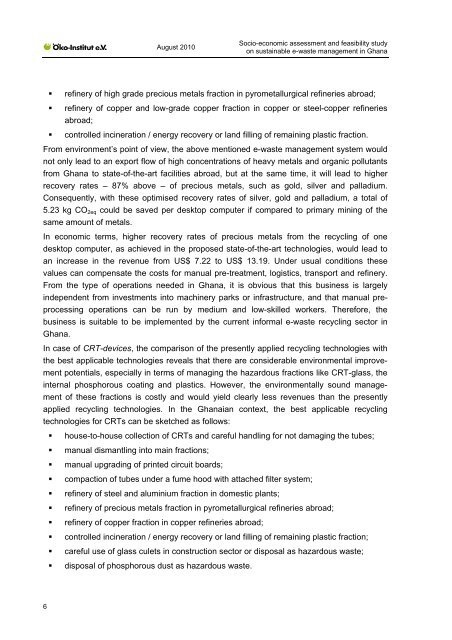Socio-economic assessment and feasibility study on - Öko-Institut eV
Socio-economic assessment and feasibility study on - Öko-Institut eV
Socio-economic assessment and feasibility study on - Öko-Institut eV
Create successful ePaper yourself
Turn your PDF publications into a flip-book with our unique Google optimized e-Paper software.
6<br />
August 2010<br />
<str<strong>on</strong>g>Socio</str<strong>on</strong>g>-<str<strong>on</strong>g>ec<strong>on</strong>omic</str<strong>on</strong>g> <str<strong>on</strong>g>assessment</str<strong>on</strong>g> <str<strong>on</strong>g>and</str<strong>on</strong>g> <str<strong>on</strong>g>feasibility</str<strong>on</strong>g> <str<strong>on</strong>g>study</str<strong>on</strong>g><br />
<strong>on</strong> sustainable e-waste management in Ghana<br />
� refinery of high grade precious metals fracti<strong>on</strong> in pyrometallurgical refineries abroad;<br />
� refinery of copper <str<strong>on</strong>g>and</str<strong>on</strong>g> low-grade copper fracti<strong>on</strong> in copper or steel-copper refineries<br />
abroad;<br />
� c<strong>on</strong>trolled incinerati<strong>on</strong> / energy recovery or l<str<strong>on</strong>g>and</str<strong>on</strong>g> filling of remaining plastic fracti<strong>on</strong>.<br />
From envir<strong>on</strong>ment’s point of view, the above menti<strong>on</strong>ed e-waste management system would<br />
not <strong>on</strong>ly lead to an export flow of high c<strong>on</strong>centrati<strong>on</strong>s of heavy metals <str<strong>on</strong>g>and</str<strong>on</strong>g> organic pollutants<br />
from Ghana to state-of-the-art facilities abroad, but at the same time, it will lead to higher<br />
recovery rates – 87% above – of precious metals, such as gold, silver <str<strong>on</strong>g>and</str<strong>on</strong>g> palladium.<br />
C<strong>on</strong>sequently, with these optimised recovery rates of silver, gold <str<strong>on</strong>g>and</str<strong>on</strong>g> palladium, a total of<br />
5.23 kg CO2eq could be saved per desktop computer if compared to primary mining of the<br />
same amount of metals.<br />
In <str<strong>on</strong>g>ec<strong>on</strong>omic</str<strong>on</strong>g> terms, higher recovery rates of precious metals from the recycling of <strong>on</strong>e<br />
desktop computer, as achieved in the proposed state-of-the-art technologies, would lead to<br />
an increase in the revenue from US$ 7.22 to US$ 13.19. Under usual c<strong>on</strong>diti<strong>on</strong>s these<br />
values can compensate the costs for manual pre-treatment, logistics, transport <str<strong>on</strong>g>and</str<strong>on</strong>g> refinery.<br />
From the type of operati<strong>on</strong>s needed in Ghana, it is obvious that this business is largely<br />
independent from investments into machinery parks or infrastructure, <str<strong>on</strong>g>and</str<strong>on</strong>g> that manual preprocessing<br />
operati<strong>on</strong>s can be run by medium <str<strong>on</strong>g>and</str<strong>on</strong>g> low-skilled workers. Therefore, the<br />
business is suitable to be implemented by the current informal e-waste recycling sector in<br />
Ghana.<br />
In case of CRT-devices, the comparis<strong>on</strong> of the presently applied recycling technologies with<br />
the best applicable technologies reveals that there are c<strong>on</strong>siderable envir<strong>on</strong>mental improvement<br />
potentials, especially in terms of managing the hazardous fracti<strong>on</strong>s like CRT-glass, the<br />
internal phosphorous coating <str<strong>on</strong>g>and</str<strong>on</strong>g> plastics. However, the envir<strong>on</strong>mentally sound management<br />
of these fracti<strong>on</strong>s is costly <str<strong>on</strong>g>and</str<strong>on</strong>g> would yield clearly less revenues than the presently<br />
applied recycling technologies. In the Ghanaian c<strong>on</strong>text, the best applicable recycling<br />
technologies for CRTs can be sketched as follows:<br />
� house-to-house collecti<strong>on</strong> of CRTs <str<strong>on</strong>g>and</str<strong>on</strong>g> careful h<str<strong>on</strong>g>and</str<strong>on</strong>g>ling for not damaging the tubes;<br />
� manual dismantling into main fracti<strong>on</strong>s;<br />
� manual upgrading of printed circuit boards;<br />
� compacti<strong>on</strong> of tubes under a fume hood with attached filter system;<br />
� refinery of steel <str<strong>on</strong>g>and</str<strong>on</strong>g> aluminium fracti<strong>on</strong> in domestic plants;<br />
� refinery of precious metals fracti<strong>on</strong> in pyrometallurgical refineries abroad;<br />
� refinery of copper fracti<strong>on</strong> in copper refineries abroad;<br />
� c<strong>on</strong>trolled incinerati<strong>on</strong> / energy recovery or l<str<strong>on</strong>g>and</str<strong>on</strong>g> filling of remaining plastic fracti<strong>on</strong>;<br />
� careful use of glass culets in c<strong>on</strong>structi<strong>on</strong> sector or disposal as hazardous waste;<br />
� disposal of phosphorous dust as hazardous waste.

















